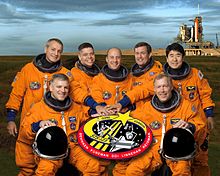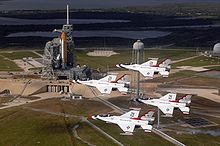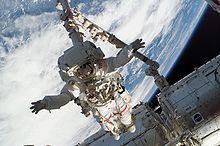

STS-123
Names
Space Transportation System-123
Mission type
ISS assembly
Operator
32699
Mission duration
15 days, 18 hours, 12 minutes, 27 seconds
Distance travelled
10,585,900 kilometres (6,577,800 mi)
Orbits completed
250
Spacecraft properties
Spacecraft
Launch mass
122,364 kilograms (269,767 lb)
Landing mass
94,158 kilograms (207,582 lb)
Crew
Crew size
7
Members
Launching
Landing
Start of mission
Launch date
March 11, 2008, 06:28:14 (2008-03-11UTC06:28:14Z) UTC[1]
Launch site
End of mission
Landing date
March 27, 2008, 00:40:41 (2008-03-27UTC00:40:42Z) UTC
Landing site
Orbital parameters
Reference system
Regime
336 kilometers (209 mi)
346 kilometers (215 mi)
51.6 degrees
91.6 minutes
Docking with ISS
Docking port
PMA-2
(Harmony forward)
Docking date
March 13, 2008, 03:49 UTC
Undocking date
March 26, 2008, 00:25 UTC
Time docked
11 days, 20 hours, 36 minutes


STS-123 was a Space Shuttle mission to the International Space Station (ISS) which was flown by Space Shuttle Endeavour. STS-123 was the 1J/A ISS assembly mission. The original launch target date was February 14, 2008, but after the delay of STS-122, the shuttle was launched on March 11, 2008. It was the twenty-fifth shuttle mission to visit the ISS, and delivered the first module of the Japanese laboratory, Japanese Experiment Module (Kibō), and the Canadian Special Purpose Dexterous Manipulator, (SPDM) Dextre robotics system to the station. The mission duration was 15 days and 18 hours, and it was the first mission to fully utilize the Station-to-Shuttle Power Transfer System (SSPTS), allowing space station power to augment the shuttle power systems. The mission set a record for a shuttle's longest stay at the ISS.[2]
Launching Astronaut
Landing Astronaut
Commander
![]() Dominic L. Pudwill Gorie
Dominic L. Pudwill Gorie
Fourth and last spaceflight
Pilot
![]() Gregory H. Johnson
Gregory H. Johnson
First spaceflight
Mission Specialist 1
![]() Robert L. Behnken
Robert L. Behnken
First spaceflight
Mission Specialist 2
![]() Michael Foreman
Michael Foreman
First spaceflight
Mission Specialist 3
![]() Richard M. Linnehan
Richard M. Linnehan
Fourth and last spaceflight
Mission Specialist 4
![]() Takao Doi, JAXA
Takao Doi, JAXA
Second and last spaceflight
Mission Specialist 5
![]() Garrett Reisman
Garrett Reisman
Expedition 16
First spaceflight
ISS Flight Engineer
![]() Léopold Eyharts, ESA
Léopold Eyharts, ESA
Expedition 16
Second and last spaceflight
ISS Flight Engineer


Location
Cargo
Mass
Bay 1–2
Orbiter Docking System
EMU 3003 / EMU 3004
1,800 kilograms (4,000 lb)
~260 kilograms (570 lb)
Bay 3P
Shuttle Power
Distribution Unit (SPDU)
~100 kilograms (220 lb)
Bay 3S
Canadarm2 Yaw Joint
336 kilograms (741 lb)
Bay 4P
MISSE PEC 6a
103 kilograms (227 lb)
Bay 4S
Direct Current Switching Unit (DCSU)
363 kilograms (800 lb)
Bay 5P
MISSE PEC 6b
103 kilograms (227 lb)
Bay 5S
Direct Current Switching Unit (DCSU)
363 kilograms (800 lb)
Bay 6S
Standard Interface Panels
?
Bay 7–8
Dextre on Spacelab Pallet
3,485 kilograms (7,683 lb)
Bay 9P
ECSH (EVA Cargo Stowage) on APC
~100 kilograms (220 lb)
Bay 10–12
Kibō ELM-PS
8,484 kilograms (18,704 lb)
Bay 11S
Standard Interface Panels
?
Bay 13P
Lightweight adapter plane for MISSE
244 kilograms (538 lb)
Bay 13S
USAF RIGEX experiment
315 kilograms (694 lb)
Starboard Sill
~450 kilograms (990 lb)
Port Sill
410 kilograms (900 lb)
Total:
16,916 kilograms (37,293 lb)
STS-123 delivered the pressurized section of the Japanese Experiment Logistics Module (ELM-PS) as well as the Special Purpose Dexterous Manipulator (SPDM) to the International Space Station. The SPDM was delivered disassembled on a Spacelab Pallet (SLP) and assembled during three spacewalks once it was at the station.
In August 2007, STS-123 crew members participated in crew equipment interface tests for the ELM-PS at Kennedy Space Center.[3] Processing continued on schedule for Endeavour's launch in early 2008. NASA engineers applied the same ECO sensor modifications used on STS-122's external tank, to Endeavour's tank. In January, a HEPA filter contamination issue was discovered, but was resolved and with no impact to the mission.[4]
On February 11, 2008, Endeavour was "rolled over" to the Vehicle Assembly Building in preparation for mating with the external tank and solid rocket boosters.[4] On February 13, 2008, Endeavour was successfully mated with its external tank and solid rocket boosters, and was rolled out to Launch Pad 39A in the early hours of February 18, 2008, for its planned launch on March 11, 2008.[5][6] The Terminal Countdown Demonstration Test, a full dress rehearsal for launch with the crew, took place February 23–25, 2008.[7]

The mission marked:
Flight days are based on the days as experienced by the astronauts, who are generally in a day-and-night pattern that is not equal to that of the launch site. The first flight day is the day of launch for the astronauts. That day started at the launch site on March 10, 2008 (local time), with the actual launch in the early hours of the 11th and the astronauts going to bed several hours after launch. March 10, 2008, is called flight day 1 by NASA, even though the actual mission launched on March 11.
Endeavour launched on time at 02:28:14 EDT (06:28:14 UTC) early into the night of March 11, 2008, from Launch Complex 39A at the Kennedy Space Center.
The Flash Evaporator System switched from its primary controller to the backup controller during launch, and instrumentation for a few left-side control thrusters was lost due to a card failure. These anomalies were not expected to affect the mission.[9]
The shuttle closed in on the space station. The crew used a 50 ft (15 m) laser-tipped boom to inspect its wings and nose for any sign of launch damage. The inspection has been standard procedure ever since the 2003 Columbia disaster. Flight director Mike Moses said a quick look at the images the astronauts beamed down to Earth revealed no signs of trouble.
In addition to performing the inspection, the astronauts also prepared their spacesuits for the five planned spacewalks and gathered the tools they would need for the docking.[10]

Endeavour's commander, Dominic Gorie, guided the shuttle through a 360-degree backflip, known as the rendezvous pitch maneuver, to allow for full photographic surveillance of the thermal tiles on the Space Shuttle's underside before docking with the space station.[11] Docking occurred at 03:49 UTC and the hatches between the two spacecraft were opened at 05:36 UTC on.[12] After docking the pallet carrying Dextre was moved to the Payload ORU Accommodation (POA) of the Mobile Base Station (MBS) by Canadarm2.


Spacewalkers Richard Linnehan and Garrett Reisman worked on installing Dextre. However, the Spacelab pallet carrying the SPDM would not power up.[13] Engineers on the ground tried a software patch, though later suspected a design flaw in Dextre's temporary power cable caused the issue.[14]
Crew members on board Endeavour used a robotic arm to remove the Japanese Logistics Module – Pressurized Section (JLP) from Endeavour's cargo bay and attach it to the space station. The JLP was attached to its interim location on the Harmony module at 08:06 UTC.[15]
The crew spent time outfitting the Japanese Logistics Module, transferring supplies and equipment into it from Space Shuttle Endeavour. The station's arm operators grappled the Canadian-built Dextre Friday at 01:59 UTC. Canadarm2 successfully powered up Dextre 11 minutes later. Mission Specialists Rick Linnehan and Mike Foreman spent the night in the station's Quest Airlock in preparation for the second spacewalk of the mission.[16]
Dextre was put together today during the second spacewalk of STS-123. Mission Specialists Richard Linnehan and Mike Foreman completed their 7-hour, 8-minute orbital stroll Sunday at 06:57 UTC. The spacewalkers encountered some difficulty removing two bolts that secured the robot arm during transport, and had to resort to using a prybar to remove them.
Throughout the day, the station and shuttle crew members continued outfitting the Japanese Logistics Module – Pressurized Section.[17]
The crews continued outfitting the Japanese Logistics Module – Pressurized Section, transferring supplies and equipment into it from Endeavour, as well as configuring racks inside the module. The crews tested the brakes in the robotic system's arms. One of the joints in the arm seemed to be operating right on the required margin. Engineers expressed confidence that this issue would be resolved
Rick Linnehan and Robert Behnken ended their day by "camping out" in the station's Quest Airlock.[18]
Linnehan and Behnken began the third EVA at 22:51 UTC. The excursion lasted six hours and 53 minutes. Linnehan and Behnken installed a spare parts platform, cameras, and tool handling assembly for Dextre. Among other tasks, they also checked out and calibrated Dextre's end effector and attached critical spare parts to an External Stowage Platform.
They were unable to attach a materials science experiment to the Columbus module due to issues with the attachment fitting, but anticipated another opportunity later in the mission.[19]
In a day highlighted by robotics activity, Dextre was attached to a power and data grapple fixture located on the U.S. laboratory Destiny. Canadarm2 grabbed the pallet that secured Dextre during its journey to the orbital outpost and returned the pallet to Space Shuttle Endeavour's payload bay for the trip back to Earth.
The station and shuttle crews also prepared hardware to be used in a shuttle tile repair test on the next spacewalk, and got some much needed off duty time.[20]
The crews of Space Shuttle Endeavour and the International Space Station got some off-duty time at the beginning of their 10th day in orbit. They also spoke to Japanese Prime Minister Yasuo Fukuda and participated in interviews with U.S. media.
The astronauts spent the remainder of their day configuring tools for the fourth STS-123 spacewalk and reviewing spacewalk procedures. Before going to sleep, Mission Specialists Robert L. Behnken and Mike Foreman entered the station's Quest airlock for the standard "camp out".[21]
Mission Specialists Robert L. Behnken and Mike Foreman completed the fourth STS-123 spacewalk at 04:28 UTC, spending six hours and 24 minutes on the excursion. The two shuttle crew members replaced a failed Remote Power Control Module — essentially a circuit breaker — on the station's truss. However, there were difficulties removing a power connector from the Z1 truss.
With Mission Specialist Rick Linnehan coordinating their activities from inside the orbiting complex, the spacewalkers also tested a repair method for damaged heat resistant tiles on the Space Shuttle. This technique used a caulk-gun-like tool named the Tile Repair Ablator Dispenser to dispense a material called Shuttle Tile Ablator-54 into purposely damaged heat shield tiles. The sample tiles will be returned to Earth to undergo extensive testing on the ground.[22]
The STS-123 crew performed the final inspection of Space Shuttle Endeavour's heat shield using the shuttle's robot arm and the Orbiter Boom Sensor System (OBSS). Gorie, Johnson, and Doi surveyed the orbiter's wings and nose cap to ensure that no damage had occurred to the tiles that protect Endeavour from the heat of reentry.
The crews spent the remainder of their day configuring tools and reviewing procedures for the flight's final spacewalk. This included the standard "camp out" in the station's Quest airlock for Behnken and Foreman.[23]

Michael Foreman and Robert Behnken completed their six-hour EVA at 02:36 (UTC), attaching a 50 ft (15 m) inspection pole to the International Space Station and completing other chores. Foreman and Behnken hooked an extra-long power cord to the inspection pole, to keep its lasers and cameras warm for the next two months, then secured the boom to the outside of the space station.
After finishing that task, Foreman inspected a jammed rotating joint that has restricted the use of a set of solar wings for months. NASA hopes to have a plan for dealing with the jammed joint by the end of the month, space station flight director Dana Weigel said.[24]
The crews of Space Shuttle Endeavour and the International Space Station completed their last full day together.
Much of the astronauts' morning was off-duty time. Afterward, the crews wrapped up transfers of equipment and supplies between Endeavour and the station, and out the tools needed for undocking and subsequent activities.
The STS-123 and Expedition 16 crews also held a joint crew news conference, answering questions from members of the media on Earth.[25]

The hatches between Endeavour and the International Space Station closed around 21:49 UTC, ending a 12-day stay at the ISS, with a scheduled undocking of 23:57 UTC. Because of problems with a command sent to solar arrays in the ISS, the undocking was delayed 28 minutes and occurred at 00:25 UTC.
The crew of Space Shuttle Endeavour spent Tuesday getting ready for its journey home and the end of the STS-123 mission. Early in their day, the crew members performed a test of the thrusters that will be used to position the orbiter for re-entry and the control surfaces for its flight through the atmosphere.
The STS-123 astronauts also set up the recumbent seat for Mission Specialist Léopold Eyharts, who joined the crew of Endeavour on the International Space Station. The recumbent seat is a special seat designed to reduce the stress of gravity on those who have spent long periods of time in the weightless environment of space.[26]

Flight controllers gave a no-go on de-orbit for the first landing opportunity at 23:05 UTC (19:05 EDT), due to unfavorable weather conditions at the Shuttle Landing FacilityatKennedy Space Center.[27]
Weather conditions were acceptable for the second landing opportunity, planned for 00:39 UTC March 27, 2008 (20:39 EDT March 26, 2008). The landing occurred at the Shuttle Landing Facility, and was the sixteenth night landing of the Space ShuttleatKSC, 22nd Shuttle night landing overall. Coincidentally, this mission also began with a night launch.
The second landing opportunity was a complete success with main gear touchdown occurring at 20:39:08 EDT (00:39:08 UTC March 27, 2008), nose gear touchdown at 20:39:17 EDT (00:39:17 UTC March 27, 2008), and wheels stop at 20:40:41 EDT (00:40:41 UTC March 27, 2008), completing the STS-123 crew's 16 days, 14 hours, 12 minutes, 27 seconds space voyage.
The exhaust produced by the Hydrazine Gas Generator APUs on either side of Endeavour's tail fin created concern among some observers that something was amiss, as it appeared more pronounced than usual in NASA's visual light cameras.[28] However, this exhaust is normal and expected. The three Hydrazine Gas Generator APUs are activated five minutes before the deorbit burn and are running for five minutes after wheels stop. The mono-propellant hydrazine changes phase due to a catalyst and reaches 1,700 °F (927 °C).[29] The hydraulic power is needed for the shuttle's rudder/speed brake, elevons, body flap and landing gear during descent, and for the main engine nozzles' gimballing during ascent. Each of the Solid Rocket Boosters have two similar Hydrazine Gas Generators for their nozzle gimballing.
Five spacewalks took place during the flight.[30][31] The cumulative time in extra-vehicular activity during the mission was 33 hours and 28 minutes.
EVA
Spacewalkers
Start (UTC)
End
Duration
Mission
EVA 1
Richard M. Linnehan
Garrett E. Reisman
March 14, 2008
01:18
March 14, 2008
08:19
7 hours, 01 minutes
Installation of ELM-PS and Dextre assembly.
EVA 2
Linnehan
Michael J. Foreman
March 15, 2008
23:49
March 16, 2008
06:57
7 hours, 08 minutes
Dextre assembly (cont.).
EVA 3
Linnehan
Robert L. Behnken
March 17, 2008
22:51
March 18, 2008
05:44
6 hours, 53 minutes
Dextre assembly (cont.), prepare the Spacelab Logistics Pallet for landing, transfer a spare Canadarm2 yaw join, transfer two spare Direct Current Switching Units Mission and unsuccessful attempted installation of the MISSE 6 experiment on the exterior of the Columbus module.
EVA 4
Behnken
Foreman
March 20, 2008
22:04
March 21, 2008
04:28
6 hours, 24 minutes
Replacement of Remote Power Control Module and test of tile repair material. Removal of a sock covering the left hand of Dextre and some launch locks on Harmony. Release launch locks on Harmony's port and nadir Common Berthing Mechanisms
EVA 5
Behnken
Foreman
March 22, 2008
20:34
March 23, 2008
02:36
6 hours, 02 minutes
Storage of Shuttle Orbiter Boom Sensor System on the Station, installation of ELM‐PS trunnion covers, removed five covers from the starboard SARJ and performed inspections, captured digital photography, successful installation of the MISSE 6 experiment on the exterior of the Columbus module and debris collection.
NASA began a tradition of playing music to astronauts during the Gemini program, which was first used to wake up a flight crew during Apollo 15. Each track is specially chosen, often by their families, and usually has a special meaning to an individual member of the crew, or is applicable to their daily activities.[32]
Flight Day
Song
Artist/Composer
Played for
Links
Day 2
Day 3
"Godzilla"
Day 4
Day 5
"Turn! Turn! Turn! (To Everything There is a Season)"
Day 6
"We're Going to be Friends"
Day 7
"God of Wonders"
Day 8
"Sharing the World"
Day 9
Day 10
Day 11
"Blue Sky"
Big Head Todd and the Monsters
Day 12
Day 13
Day 14
"I Am Free"
Friendswood United Methodist Church
Day 15
"Home"
Day 16
Day 17
Train
STS-324 was the designation given to the Contingency Shuttle Crew Support mission which would have been launched in the event Space Shuttle Endeavour became disabled during STS-123.[33] It would have been a modified version of the STS-124 mission and would have involved the launch date being brought forward. The crew for this mission would have been a four-person subset of the full STS-124 crew.[33]
![]() This article incorporates public domain material from websites or documents of the National Aeronautics and Space Administration.
This article incorporates public domain material from websites or documents of the National Aeronautics and Space Administration.
Flights
Status
On display
See also: {{ISS expeditions}}, {{Uncrewed ISS flights}}
1998–2004
2005–2009
2010–2014
2015–2019
Since 2020
Future
Individuals
Vehicles
Completed
(crews)
1970s
1980s
1990s
2000s
2010s
January
February
March
April
May
June
July
August
September
October
November
December
Launches are separated by dots ( • ), payloads by commas ( , ), multiple names for the same satellite by slashes ( / ).
Crewed flights are underlined. Launch failures are marked with the † sign. Payloads deployed from other spacecraft are (enclosed in parentheses).